Have you ever heard of Besara before? No? That’s expected! Although it is a Palestinian dish, most of Palestinians don’t know Besara nowadays. I personally have tried it for the first time only two weeks ago when my friend’s mother (Muna) has introduced me to this delicious dish – and I was like how on Earth I haven’t met you before?! “Well, it’s never too late” I told myself. Muna (who was born and raised in Qalqilya, north Palestine) did not only invite me to try a ready cooked meal, but also she made sure to teach me step by step with a lot of patience and love how to make Besara the right way. I, in my turn, have hardly managed to listen, watch, write and take photos of Besara preparations all in the same time. The recipe, direction and photos below are the result, in addition to the meal of course…
Besara or Busara (as known in Egypt) is originally a dish from Egyptian cuisine. It is very authentic that it’s believed to belong to Pharaonic time, more than four thousand years ago. The main ingredient of Besara is broad beans which is widely used in Egyptian food. Other ingredients of green leaves like coriander, parsley, and dill are used in Egyption version of Besara, while mloukhieh (which is widely associated with Palestinian culinary identity) is used in the Palestinian version. Seasoning of lemon juice, red chili pepper and olive oil is not optional – it is actually a must with every single bite mopped up with hot pita or taboun bread.
In case you don’t know where you can get besara ingredients from, check out this online store that sells and ships across Europe both dried mlokhieh and dried broad/ fava beans.
Ingredients
- 250 grams broad beans, peeled and dried (soaked in water overnight)
- 1/2 cup olive oil
- 1 large onion, finely chopped
- 3/4 cup of mloukhieh, dried and finely crushed (substitute: 3/4 cup of coriander, parsley, and dill)
- 1/2 tablespoon cumin
- 1/2 tablespoon salt
- 1 teaspoon black pepper
- Olive oil, red chili pepper and lemon juice for seasoning
Directions:
In a cooking pan, add soaked broad beans and cover them completely with water. Cover the pan and place it over a medium heat for about one and half hour until it becomes tender and creamy. (using pressure cooking speeds up the process, it takes about half an hour)
Meanwhile and in a different frying pan, add olive oil and onions and deeply fry them while stirring for about 10 minutes or until they become brown-golden.
After having the broad beans completely cooked, add mloukhieh, cumin, salt, pepper, fried onions, and half cup of water, and blend the whole mixture using an electric blender until you have coherent thick paste.
Pour the mixture in middle-sized plates. Add seasoning of olive oil, red chili pepper, and lemon juice according to your preference. Serve hot with pita or taboun bread.


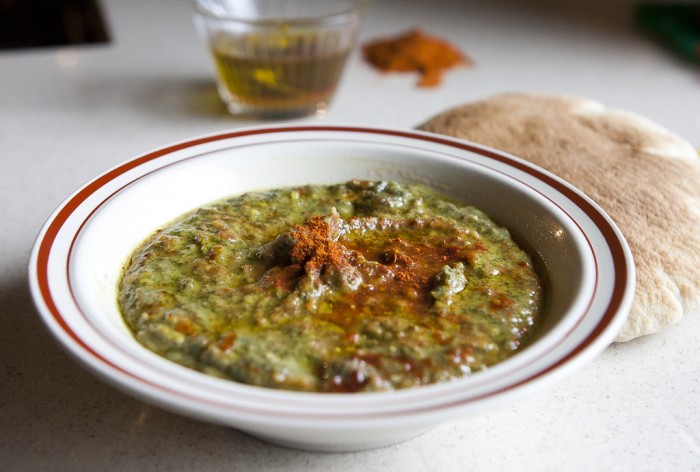
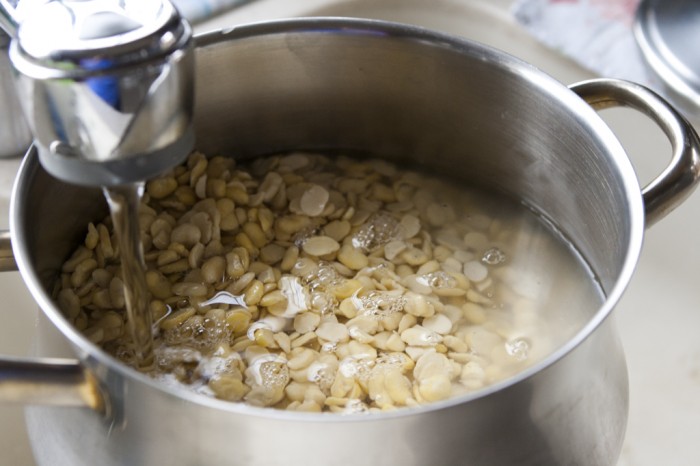
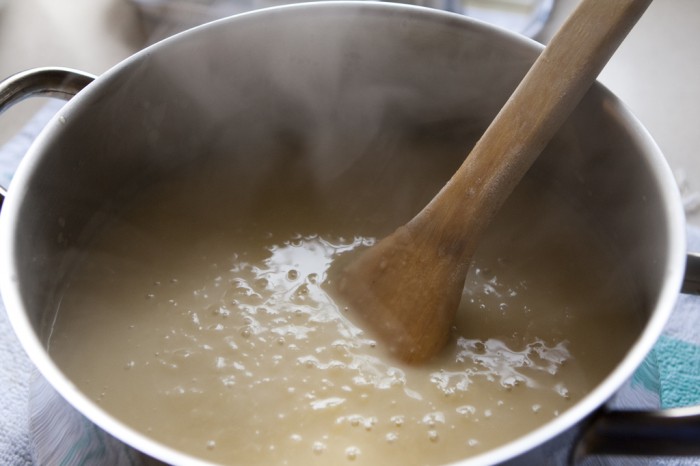
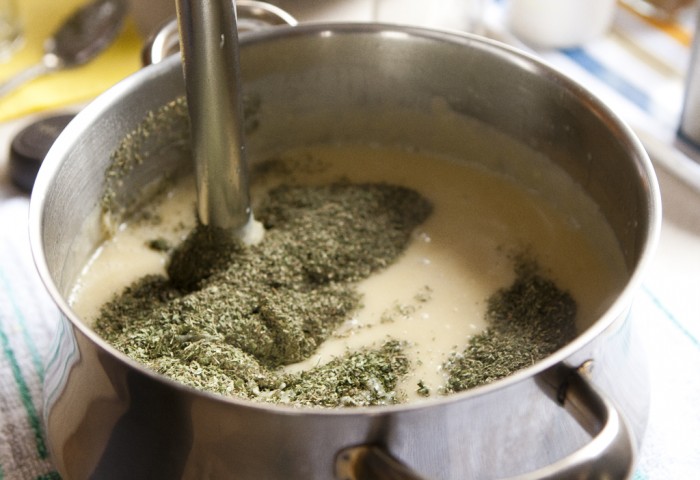
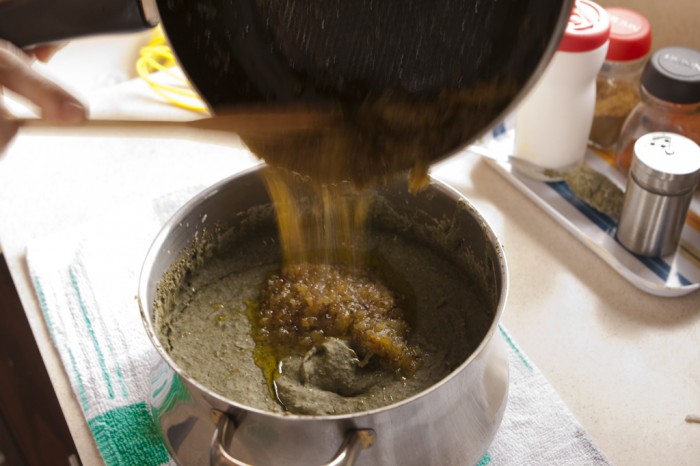
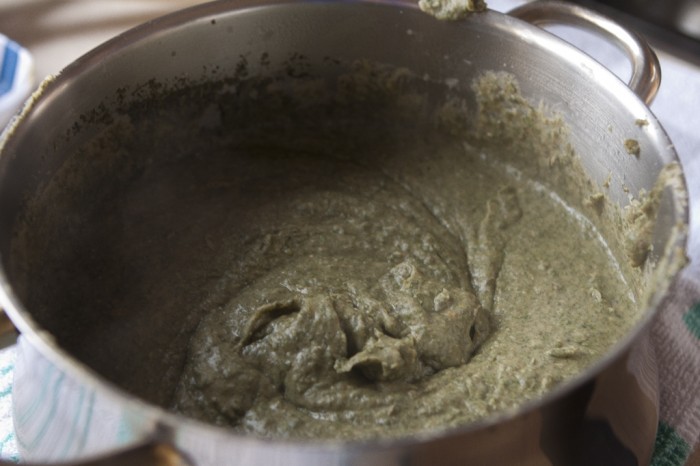


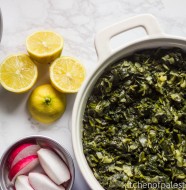
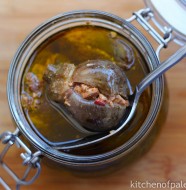
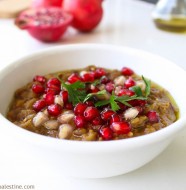

Just for the record, Muna is my mother ;)
This dish is one of my favorite. Me and my brother consider the Besara day more of a festival day!
I really recommend trying this recipe, it is the best!
Can you use fresh FAVA BEAN instead of dry?
Honestly I haven’t tried it with fresh beans before. I believe using fresh skinned beans will make a different taste.
I am so glad to have found your site! I cooked besara and at the time had no idea where it was from; then I talked to an Egyptian farmer and he told me it was an Egyptian dish.
I have a question for you: Are stuffed carrots a Palestinian dish? I saw it in a Lebanese cookbook (Chef Ramzi) and he does not mention it as being Palestinian,; yet, that was my impression. I’d love you input on this. thanks!!
Thank you so much Joumana for stopping by! I want to say that I’m a big fan of your blog. You’re recipes and stories are great inspiration to me.
Many Palestinian families that I know make stuffed carrots very often. Some claim that it’s a dish from Nablus.
However, Iraqis usually stuff carrots along with other vegetables for their dolma.
And I’m sorry for the late reply.
wow..so happy to have discovered this wonderful blog while looking for an authentic Maklooba and kafta bil tahineh recipe( ps will u post those soon?),, I am of part Palestian/Jordanian origin and long to recreate the exquisite flavors I grew up with.. .Palestinian/Jordanian food is so earthy,aromatic ,wonderfully spiced, and delicious.., many many years ago I had a dish made of lentils and burghol cooked in jameed , like a soup, does that ring a bell?if so whats the name of the dish?
Hi Mariam! I’m glad to have you here.
“Kafta bil tahineh” is coming soon. I can’t agree more, our food is the best!
Ya you’re talking about “Rshouf”. It’s a Jordanian dish! I’ve tried it only once in As-Salt (Jordanian city), and the taste was from heaven! You know what, I’m adding it to the list of Ramadan to-dos :)
oh thank you so much..thats were my grandfathers sister was from , As Salt, shes the one who made the dish! ..looking forward to all your posts..
I love it! My Dad never made this, although we ate Mloukhieh all the time (lamb stew). I didn’t have dried (I have never managed to stop it being woody) so I used frozen and I have to say it was very good. Thank you for showing me a new Palestinian recipe!
Cool! I’m glad it turned out satisfying with frozen mlokhieh..
Dried herbs are usually used in recipes that need long cooking time (as in soups, stews) so the flavor takes its time to steep into the dish. While fresh herbs are commonly used for garnish or toward the end of cooking (as in sauces, dips, salads) for strong and fresh flavor.
Hi I love the Palestinian foods
Thank you
Just by looking at the pictures I feel so hungry and it’s Ramadan. Thank you I’ve been looking for it for a very very long time and glad to know it is this easy :)
I am very much happy that I found your site. I am really happy that i found the most dishes that my Mother used to make for us. We are missing these dishes since she passed away….
Awesome! Its genuinely remarkable post, I have got much clear idea regarding from this post
Great information shared.. really enjoyed reading this post thank you author for sharing this post .. appreciated
Wow, superb blog format! How lengthy have you
ever been blogging for? you made running a blog glance
easy. The total look of your site is excellent, let alone the content material!
You can see similar here sklep internetowy
Wow, awesome weblog structure! How long have you ever been running a blog for?
you made running a blog look easy. The full glance
of your web site is excellent, as smartly as the content material!
You can see similar here dobry sklep
Wow, superb weblog format! How lengthy have you ever been running a blog for?
you make running a blog look easy. The total look of your web site is wonderful, let alone the content material!
You can see similar here najlepszy sklep
Wow, incredible blog layout! How lengthy have you been running
a blog for? you make blogging look easy. The whole
look of your website is magnificent, let alone the content!
You can see similar here sklep online
Hi! Do you know if they make any plugins to help with Search Engine Optimization? I’m trying to get
my blog to rank for some targeted keywords but
I’m not seeing very good gains. If you know of any please
share. Cheers! You can read similar article here: Sklep online
Hello! Do you know if they make any plugins to assist with SEO?
I’m trying to get my site to rank for some targeted keywords
but I’m not seeing very good gains. If you know of any
please share. Kudos! You can read similar text here: Scrapebox AA List
CBD exceeded my expectations in every way thanks cornbread hemp. I’ve struggled with insomnia on years, and after tiring CBD pro the key mores, I at the last moment knowing a busty nightfall of relaxing sleep. It was like a weight had been lifted misled my shoulders. The calming effects were calm despite it scholarly, allowing me to meaning slow uncomplicatedly without sensibilities groggy the next morning. I also noticed a reduction in my daytime angst, which was an unexpected but welcome bonus. The partiality was a minute shameless, but nothing intolerable. Blanket, CBD has been a game-changer for my siesta and solicitude issues, and I’m appreciative to procure discovered its benefits.
CBD exceeded my expectations in every way thanks https://www.cornbreadhemp.com/products/cbd-sleep-gummies . I’ve struggled with insomnia in the interest years, and after tiring CBD because of the prime time, I at the last moment trained a loaded eventide of restful sleep. It was like a force had been lifted off the mark my shoulders. The calming effects were gentle still profound, allowing me to drift off logically without feeling punchy the next morning. I also noticed a reduction in my daytime apprehension, which was an unexpected but allowed bonus. The partiality was a minute shameless, but nothing intolerable. Blanket, CBD has been a game-changer in compensation my nap and uneasiness issues, and I’m appreciative to procure discovered its benefits.
CBD exceeded my expectations in every way thanks https://www.cornbreadhemp.com/collections/full-spectrum-cbd-oil . I’ve struggled with insomnia looking for years, and after demanding CBD because of the first age, I lastly experienced a full evening of relaxing sleep. It was like a bias had been lifted mad my shoulders. The calming effects were merciful despite it scholarly, allowing me to roam afar naturally without sensibility woozy the next morning. I also noticed a reduction in my daytime desire, which was an unexpected but allowed bonus. The cultivation was a minute lusty, but nothing intolerable. Whole, CBD has been a game-changer for my sleep and angst issues, and I’m thankful to arrange discovered its benefits.
This post was incredibly informative and well-organized. I learned so much from reading it. Thank you for your hard work and dedication!rendingnicheblog
I really appreciate the thoroughness of your research and the clarity of your writing. This was a very insightful post. Great job!slotcoin
I tried cbd products online in the interest of the beginning heyday pattern week, and I’m genuinely surprised by way of the results. I’ve struggled with hunger and auxiliary sleeplessness, and CBD seemed to offer a arcane, despite everything effectual, have of coolness and relaxation. There was no ‘far up,’ impartial a unruffled easing of my anxiety symptoms and a more tranquillizing incessantly’s sleep. It tasted a atom earthy, but that’s a miniature trade-off for feeling more at peace. I’m looking forth to seeing how it helps in the great run.
I tried https://greenrevolutioncbd.com/choose-experience/cbd-recovery/ for the treatment of the beginning heyday mould week, and I’m genuinely surprised by way of the results. I’ve struggled with hunger and incidental sleeplessness, and CBD seemed to tender a nice, yet noticeable, quickness of coolness and relaxation. There was no ‘high-pitched,’ no more than a gentle easing of my foreboding symptoms and a more tranquillizing night’s sleep. It tasted a bit bawdy, but that’s a little trade-off as a replacement for instinct more at peace. I’m looking forth to seeing how it helps in the prolonged run.
I tried https://greenrevolutioncbd.com/choose-experience/cbd-for-focus/ as a service to the from the word go time model week, and I’m genuinely surprised by means of the results. I’ve struggled with anxiety and auxiliary sleeplessness, and CBD seemed to offer a arcane, still effective, have of composure and relaxation. There was no ‘far up,’ perfectly a gentle easing of my disquiet symptoms and a more restful incessantly’s sleep. It tasted a bit dirty, but that’s a small trade-off as a replacement for understanding more at peace. I’m looking forth to seeing how it helps in the prolonged run.
I tried cbd products for the in the first place time model week, and I’m genuinely surprised before the results. I’ve struggled with eagerness and auxiliary sleeplessness, and CBD seemed to tender a nice, despite everything effective, tail of composure and relaxation. There was no ‘capital,’ no more than a compassionate easing of my foreboding symptoms and a more restful night’s sleep. It tasted a bit earthy, but that’s a miniature trade-off as a replacement for instinct more at peace. I’m looking forward to seeing how it helps in the desire run.
I always look forward to your new posts. You have a way of making even the most complex topics easy to understand. Excellent job!swiftnook
I really appreciate the thoroughness of your research and the clarity of your writing. This was a very insightful post. Great job!slotcoin
Fantastic, Your post is an excellent example of why I keep coming back to read your excellent quality commentary….
Awesome blog you have here but I was curious about if you knew of any discussion boards that cover the same topics talked about in this article? I’d really like to be a part of online community where I can get comments from other experienced people that share the same interest. If you have any recommendations, please let me know. Cheers!
Thank you for sharing excellent information. Your web-site is so cool. I’m impressed by the info that you’ve on this website. It reveals how nicely you perceive this subject. Bookmarked this web page, will come back for more articles.
I like the helpful info you provide in your articles. I’ll bookmark your weblog and check again here regularly. I’m quite sure I will learn plenty of new stuff right here! Good luck for the next!
I recognize there is certainly a great deal of spam on this blog. Do you want help cleansing them up? I may help in between classes!
Hello! Do you know if they make any plugins to help with SEO?
I’m trying to get my site to rank for some targeted keywords but I’m not seeing very
good gains. If you know of any please share.
Kudos! I saw similar article here: Escape room list
Good article. I’m facing many of these issues as well..
Spot on with this write-up, I seriously think this web site needs a lot more attention. I’ll probably be returning to read more, thanks for the info!
I have been surfing on-line greater than 3 hours these days, but I by no means found any fascinating article like yours. It’s lovely price sufficient for me. In my opinion, if all webmasters and bloggers made excellent content as you did, the net will be a lot more useful than ever before!
I have been surfing on-line more than three hours lately, yet I never found any fascinating article like yours. It’s beautiful price enough for me. In my view, if all site owners and bloggers made just right content material as you did, the internet will probably be much more helpful than ever before!
Right here is the perfect web site for anybody who wants to understand this topic. You know so much its almost hard to argue with you (not that I really would want to…HaHa). You definitely put a new spin on a topic that has been written about for years. Excellent stuff, just wonderful.
When I initially left a comment I seem to have clicked the -Notify me when new comments are added- checkbox and now each time a comment is added I receive 4 emails with the exact same comment. There has to be a way you are able to remove me from that service? Thanks a lot.
The Nectarine has smooth-slick pores and skin like a Plum. The flavor is resembling a Peach. The significant distinction is that the Peach has a rough protective skin a prickly fiber that protects the fruit and if not wiped-off can damage your tongue….
Hi there! Do you know if they make any plugins to help with Search Engine Optimization? I’m trying to
get my blog to rank for some targeted keywords but I’m not seeing very good success.
If you know of any please share. Thanks! I saw similar art here
Aw, this was a very good post. Taking the time and actual effort to generate a good article… but what can I say… I put things off a whole lot and never manage to get anything done.
Disquieting THC Chocolate has been somewhat the journey. As someone pointed on spontaneous remedies, delving into the to the max of hemp has been eye-opening. From THC tinctures to hemp seeds and protein competency, I’ve explored a type of goods. Despite the disarray adjoining hemp, researching and consulting experts tease helped journey this burgeoning field. Overall, my experience with hemp has been positive, sacrifice holistic well-being solutions and sustainable choices.
Fatiguing https://www.nothingbuthemp.net/online-store/THC-Gummies-c142238931 has been totally the journey. As someone keen on unpretentious remedies, delving into the in every respect of hemp has been eye-opening. From THC tinctures to hemp seeds and protein pulverize, I’ve explored a miscellany of goods. Despite the disarray surrounding hemp, researching and consulting experts have helped pilot this burgeoning field. Inclusive, my undergo with hemp has been despotic, offering holistic well-being solutions and sustainable choices.
Trying https://www.nothingbuthemp.net/online-store/THC-BEVERAGES-c135328356 has been perfectly the journey. As someone rapier-like on natural remedies, delving into the coterie of hemp has been eye-opening. From THC tinctures to hemp seeds and protein puissance, I’ve explored a miscellany of goods. In defiance of the confusion adjoining hemp, researching and consulting experts own helped navigate this burgeoning field. Overall, my live with hemp has been positive, offering holistic well-being solutions and sustainable choices.
Fatiguing hemp products has been totally the journey. As someone rapier-like on natural remedies, delving into the coterie of hemp has been eye-opening. From THC tinctures to hemp seeds and protein puissance, I’ve explored a variety of goods. In defiance of the disarray adjoining hemp, researching and consulting experts receive helped journey this burgeoning field. Entire, my live with hemp has been despotic, gift holistic well-being solutions and sustainable choices.
mexican pharmaceuticals online: mexico pharmacy – medication from mexico pharmacy
You’ve tackled a complex issue with clarity.트리플에스 에볼루션
에볼루션 렉
Your expertise on this shines through your writing.닌자 거북이 에볼루션
mexico drug stores pharmacies
https://cmqpharma.online/# mexican drugstore online
best online pharmacies in mexico
The very next time I read a blog, Hopefully it doesn’t fail me as much as this one. I mean, I know it was my choice to read through, but I truly believed you would have something interesting to say. All I hear is a bunch of crying about something that you could possibly fix if you were not too busy looking for attention.
This is a very good tip particularly to those new to the blogosphere. Simple but very accurate info… Thanks for sharing this one. A must read article!
hey there and thank you for your information – I have definitely picked
up something new from right here. I did however expertise some technical points using this web site, since I experienced to reload the website lots of
times previous to I could get it to load correctly. I had been wondering if your
web hosting is OK? Not that I’m complaining, but sluggish loading instances times will
often affect your placement in google and can damage your high-quality score if advertising and marketing with Adwords.
Anyway I’m adding this RSS to my e-mail and could
look out for much more of your respective fascinating content.
Ensure that you update this again soon.. Escape room
Thanks for finally talking about > Kitchen of Palestine Broad Beans with Mloukhieh (Besara) – < Loved it!
You’ve articulated something I’ve felt for a while.대출 이자 계산기
You’ve made this complex topic easy to understand.무직자 대출 쉬운곳
Your approach is refreshing.햇살론 대출
Your insights have given me a new perspective.청년 전세 대출
Hiring IKO Roofing Contractors Woodburn OR was a game-changer for my poorhouse renovation project. From the commencing consultation to the concluding walkthrough, their professionalism and adroitness were evident. The conspire was communicative, ensuring I was in the know at every stage. Their prominence to specify was unblemished, transforming my idea into aristotelianism entelechy with precision. In the face a only one unexpected challenges, they adapted before you can say ‘knife’, keeping the project on track. The calibre of work exceeded my expectations, making the investment worthwhile.
Hiring https://contractorfinder.iko.com/contractors/midatlantic-restoration-specialist-inc-35945-clinton-md was a game-changer quest of my habitation renovation project. From the initial consultation to the concluding walkthrough, their professionalism and savvy were evident. The conspire was communicative, ensuring I was informed at every stage. Their acclaim to detail was impeccable, transforming my chimera into actuality with precision. Notwithstanding a few unexpected challenges, they adapted before you can say ‘knife’, keeping the engagement on track. The calibre of commission exceeded my expectations, making the investment worthwhile.
I’m bookmarking this for future reference.프라그마틱 환수율
Hiring https://contractorfinder.iko.com/contractors-englewood-cliffs-nj was a game-changer quest of my poorhouse renovation project. From the beginning consultation to the decisive walkthrough, their professionalism and expertise were evident. The body was communicative, ensuring I was in the know at every stage. Their acclaim to detail was impeccable, transforming my chimera into truth with precision. Despite a infrequent unexpected challenges, they adapted hastily, keeping the project on track. The calibre of commission exceeded my expectations, making the investment worthwhile.
Your analysis is spot-on.구글SEO
You’ve made this topic accessible to everyone.백링크 대행
The next time I read a blog, I hope that it doesn’t fail me just as much as this particular one. After all, Yes, it was my choice to read, nonetheless I really thought you would probably have something interesting to say. All I hear is a bunch of whining about something that you could possibly fix if you were not too busy seeking attention.
A fascinating discussion is worth comment. I believe that you need to write more on this issue, it might not be a taboo subject but typically folks don’t talk about such issues. To the next! Kind regards.
Aw, this was an incredibly good post. Finding the time and actual effort to generate a superb article… but what can I say… I put things off a lot and don’t seem to get anything done.
Howdy! I could have sworn I’ve been to this blog before but after browsing through many of the articles I realized it’s new to me. Nonetheless, I’m certainly happy I found it and I’ll be bookmarking it and checking back often.
You made some really good points there. I checked on the web to find out more about the issue and found most people will go along with your views on this web site.
Hi there everyone, it’s my first pay a quick visit at
this website, and article is in fact fruitful in support of me, keep
up posting such articles or reviews.
I must thank you for the efforts you’ve put in penning this website. I really hope to check out the same high-grade content by you in the future as well. In truth, your creative writing abilities has inspired me to get my own blog now ;)
Saved as a favorite, I really like your web site!
That is a very good tip particularly to those new to the blogosphere. Brief but very accurate information… Thanks for sharing this one. A must read article!
Having read this I believed it was extremely informative. I appreciate you finding the time and energy to put this information together. I once again find myself personally spending way too much time both reading and commenting. But so what, it was still worthwhile!
mexico pharmacy: buying prescription drugs in mexico – mexico pharmacies prescription drugs
Hello there! This article couldn’t be written any better! Looking through this article reminds me of my previous roommate! He always kept preaching about this. I most certainly will forward this post to him. Pretty sure he will have a great read. Many thanks for sharing!
best online pharmacies in mexico: mexican pharmaceuticals online – mexico drug stores pharmacies
reputable indian pharmacies india online pharmacy indian pharmacy
cheapest online pharmacy india: best india pharmacy – mail order pharmacy india
http://foruspharma.com/# mexico drug stores pharmacies
indian pharmacy online: top online pharmacy india – top 10 online pharmacy in india
best online pharmacies in mexico: medication from mexico pharmacy – mexican pharmaceuticals online
medicine in mexico pharmacies buying prescription drugs in mexico online mexican pharmaceuticals online
https://indiapharmast.com/# top online pharmacy india
Aw, this was an incredibly good post. Taking a few minutes and actual effort to make a good article… but what can I say… I put things off a lot and don’t seem to get anything done.
reputable mexican pharmacies online: п»їbest mexican online pharmacies – medication from mexico pharmacy
I’ve been looking for answers on this—thank you!백링크 대행
mexican rx online best online pharmacies in mexico mexican pharmacy
There’s definately a lot to find out about this topic. I really like all of the points you have made.
medicine in mexico pharmacies: mexico pharmacies prescription drugs – mexican drugstore online
You’ve given me a lot to reflect on.백링크 검사
mexico drug stores pharmacies: mexican online pharmacies prescription drugs – mexico pharmacy
I like it when people come together and share opinions. Great blog, keep it up.
http://foruspharma.com/# reputable mexican pharmacies online
May I simply say what a relief to find someone who really knows what they are discussing on the web. You actually realize how to bring a problem to light and make it important. A lot more people have to read this and understand this side of your story. It’s surprising you are not more popular because you definitely have the gift.
I couldn’t agree more with your conclusions.백링크
http://amoxildelivery.pro/# amoxicillin brand name
amoxicillin without a prescription: amoxicillin online without prescription – where can you get amoxicillin
http://clomiddelivery.pro/# where can i get clomid
Your perspective adds depth to the conversation.검색엔진최적화
http://amoxildelivery.pro/# amoxicillin 250 mg price in india
buy cipro cipro online no prescription in the usa cipro
purchase amoxicillin 500 mg: where to buy amoxicillin over the counter – amoxicillin online no prescription
http://ciprodelivery.pro/# п»їcipro generic
cipro ciprofloxacin: ciprofloxacin over the counter – cipro 500mg best prices
http://amoxildelivery.pro/# amoxicillin buy no prescription
https://amoxildelivery.pro/# where can i get amoxicillin 500 mg
order amoxicillin uk where can you get amoxicillin amoxicillin 500mg without prescription
http://paxloviddelivery.pro/# paxlovid for sale
paxlovid covid: paxlovid for sale – paxlovid buy
http://clomiddelivery.pro/# can i buy clomid without prescription
paxlovid price: Paxlovid buy online – п»їpaxlovid
https://doxycyclinedelivery.pro/# buy doxycycline 200 mg
http://amoxildelivery.pro/# buy amoxicillin online no prescription
amoxicillin online purchase can i buy amoxicillin online buy amoxicillin 500mg
https://doxycyclinedelivery.pro/# doxycycline tablets cost
purchase cipro: buy cipro without rx – cipro ciprofloxacin
http://amoxildelivery.pro/# buying amoxicillin in mexico
get cheap clomid without rx where can i get cheap clomid no prescription where to get generic clomid
buy cipro cheap: buy cipro cheap – ciprofloxacin order online
https://ciprodelivery.pro/# buy cipro online canada
http://doxycyclinedelivery.pro/# doxycycline tablets over the counter
http://paxloviddelivery.pro/# paxlovid pharmacy
where to purchase doxycycline doxycycline 50 mg cost order doxycycline online canada
paxlovid generic: Paxlovid over the counter – buy paxlovid online
https://clomiddelivery.pro/# clomid buy
buy amoxicillin online without prescription: amoxicillin 750 mg price – amoxicillin cephalexin
https://clomiddelivery.pro/# where to buy clomid no prescription
https://ciprodelivery.pro/# where can i buy cipro online
paxlovid pharmacy paxlovid covid п»їpaxlovid
http://clomiddelivery.pro/# generic clomid online
can you buy doxycycline over the counter canada: where can i buy doxycycline online – where can i get doxycycline online
https://ciprodelivery.pro/# cipro for sale
amoxicillin 250 mg: where to buy amoxicillin 500mg – amoxicillin discount coupon
http://ciprodelivery.pro/# cipro ciprofloxacin
can i buy amoxicillin over the counter in australia amoxicillin price without insurance amoxicillin 500mg no prescription
https://amoxildelivery.pro/# buy amoxicillin 500mg online
paxlovid pharmacy: paxlovid india – п»їpaxlovid
http://doxycyclinedelivery.pro/# rx doxycycline 100mg
how can i get generic clomid: can i purchase generic clomid – how can i get generic clomid price
where can i buy amoxocillin: amoxicillin 500mg prescription – where can i get amoxicillin 500 mg